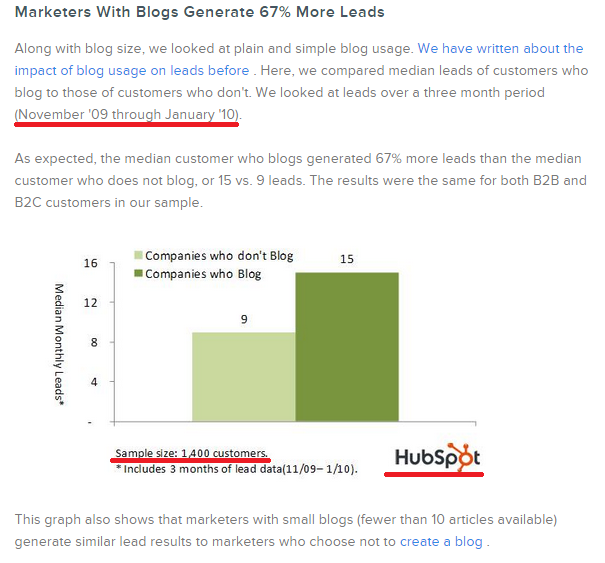With the introduction of the internet, fact checking is no longer the domain of scholars and journalists. Instead, anyone who can work a search engine, can type in a query and follow the bread crumbs to its source.
Yet, even with the resources for fact-check at our fingertips, content marketers often don’t do spend time doing these checks. Instead, we take most statements at face value – not from its original source, but from the person who quoted it – and popularize it by spreading the information.
Whether we do it because we don’t have time (I’m guilty for cutting corners ever now and again when I feel under pressure to create content), or we just don’t realize the importance of fact checking, the end-result remains the same: Our blogs are littered with inaccuracies and misinformation.
And worse: Our audience are making decisions based off of our posts – decisions that may have been different if we had taken to time to ensure that what we said was true.
The Importance of Facts
Facts paint a fuller picture, present to us a reality from which we can be confident in, understand and make decisions based off of those experiences and challenges. Without facts (and their subsequent fact checking) we’d move forward on the basis of misinformation, and our decisions may be influenced one way or another due to incorrect assumptions.
But our jobs aren’t easy.
With the power of the internet, and the huge flow of information that we have access to, the more we misinformation we have to filter through.
So why bother?
1. Build Trust
The greatest businesses in the world have all utilized one key strategy to get people to buy with them: Trust.
And if you truly want to build a brand based on trust (and you should) then it should start with painting as clear a picture as you possibly can for your customers – and that means checking your facts.
The very simple truth is that nothing destroys a customer’s trust in a business more than discovering that they’ve been misled.
2. Grow Your Authority
Growing your authority in your preferred industry is vital. Having authority, or a name for yourself, is like having been one the first to have climbed out of the ever expanding sea of content. Standing above the sea of content, you call down and tell everyone what they can do to get there too. Some take your advice, some don’t. But when others find their way to safety, it’s validated your expertise and more follow.
Suddenly, we go from struggling to be heard, to the voice that everyone wants to listen to. We become a leader, a force for good, someone who can actually get results. We become valuable.
But imagine the same scene, but you’ve misrepresented some information. For example, you didn’t quite tell them that you had friends that helped you out. This key detail helped you get started, and by leaving it out you’ve doomed others who try to emulate you to failure. Quickly, everyone will see that you can’t help them and they’ll look to someone else who can.
Fact checking can increase your authority because people who read your posts, and are influenced by them, will rally about its effectiveness. You’ll create brand advocates, generate Word of Mouth Advertising and becoming an authority all in one go.
3. Stand Out From the Crowd
Let’s go back to our climbing from the sea of content metaphor for just a moment. Imagine that there are a bunch of people have discovered how to rise above the sea of content through their own methods.
While each person relays what they did to succeed, they all keep something back. Vital facts that mean that no one can emulate their efforts.
So you tell people the facts of your process (unglamorous as they might be) and only 1 or 2 people will try it. Why? You’re methods aren’t as glamorous or impressive as the others. But, those who tried what you’ve suggested manage to succeed and now stand above the sea of content too! Word spreads. Now, people know who to go to for real advice.
Not many content marketers will bother to check their facts. Instead, they sacrifice facts for the lure of glamour – i.e. this sounds better.
But that’s exactly why you should fact-check.
In a world where “content shock” is inevitable, where content marketers scramble to avoid being drowned out by the sea of content, fact checking can be your lifeboat.
Fact Checking 3 Content Marketing “Facts”
Fact checking isn’t always about proving something is true or false. Sometimes it’s just about creating a context for the facts that can help to paint a rounder picture.
To show you how fact checking works in practice, I thought I’d investigate 3 of the more popular content marketing facts, and show you a step-by-step guide on how I did it.
- The Dubious Statistic
“67% more leads per month are generated by companies who blog”
This little gem of a fact has circulated for years, but how much can we really trust it? Where did it originally come from? Who did the research? When?
It turns out the statistic comes from marketing automation tycoon, HubSpot.
Firstly, let’s deal with the source. Hubspot (like Spokal) runs a business for content marketers and business owners who want to be active on the web. The more urgent they make you feel blogging is, the more business they develop. (Now, don’t get me wrong – Blogging is really important for a business, but we have to keep in mind who’s speaking).
The second thing I did was to investigate their sample size. Was it larger enough to give an accurate reading? To do this, I had to find out how many customers Hubspot had in 2009. As it turned out, it Hubspot only had 1,150 customers in 2009, so now we’ve come to question exactly what 1,400 “customers” they used in the research
The third thing I noted is the date. 2009/10 was 5 years ago. Since then, the content marketing world has drastically changed. From content shock that slows down blog growth, to the huge number of companies that have began to blog, whether or not this fact is still useful for marketers today is up in the air.
Nevertheless, if you wanted to utilize this statistic in a blog post, all you’d have to do to be factually correct would be to name the body responsible for the research. For example, “In a 2009 study by HubSpot, they claimed that “67% more leads per month are generated by companies who blog”.
2. The Popular False Fact
“People process images 60 000 times faster than text”.
Have you ever heard (or read) the supposed fact that we process visual information Well, I have… plenty of times. When I was writing a recent post on creating DIY visuals, I wanted to give some solid facts on why it’s so important, and remembered reading this fact somewhere. Of course, I found plenty of people quoting the fact, but any sources just lead me back to someone else who had said it, without any study or research to back it up.
Curious (and not wanting to mislead my readers) I scoured the net for the original quote, which turns out to have been from a Jenn Manalo, Sr. Product Specialist, for 3M Coporation – but where she got the figure is still unknown.
No proof, no use.
Instead, I found a study by MIT that concluded that the brain can process an image in 13 milliseconds, and with a bit of mathematics (see? It does come in useful!) I figured out – with there being 1,000 milliseconds in a second – that would mean that we can process about 76 images per second.
Which I think is just as interesting, thank you very much!
3. The Skewed Data
The fact that statistics can be misleading is nothing new to us.
For example, Colgate were famously called out for their misleading use of statistics in an ad that claimed that “more than 80% of dentists recommend Colgate”. In turns out that the survey had allowed for dentists to choose multiple brands, so any brand could be just as popular as Colgate.
The misleading statistic and its accompanying ad was quickly banned by Advertising Standards Authority.
Equally, you’ll often hear of people claiming to have grown their email list by XYZ% – without ever giving you exact figures. Understandably, not everyone wants to reveal their figures so this may be the case. However, if you can share your figures, do. Or when you read a percentage like, take it with a grain of salt. Remember: 70% may seem like a huge increase, until you realize the person only had 1 subscriber to begin with.
How to Fact-Check for Content Marketing
1. Look for More Than One Source
The best (and most reliable) facts come from multiple sources.
For example, Oscar Wilde, who is a notable literary figure, and who was married with two children, was in fact, gay and/or bisexual. How do we know this? 1. He was arrested (and later convicted) for homosexuality (or, more specifically, “gross indecency with men”). 2. There were letters that implied he had relations with men. 3. There were gifts presented in court that Wilde admitted to giving to various young men.
2. Contextualize It
Oftentimes, you’ll find that some piece of data or information comes from one study alone. Ensure that you’re audience knows this by stating it in plain view.
For example, “One study by XYZ has shown that…” You’ve not only given the source of your information, but you’ve also ensured that your audience knows that the information comes only from one place, and therefore, is up for debate.
Likewise, as with the Skewed Data section, out of context, statistics can seem far more impressive than within context. If you can, use exact figures or estimates of figures, so that your audience gets the whole picture.
3. Wikipedia is Not a Reliable Source
Anyone can write on Wikipedia, which makes it a dubious source of information. If you stumble across Wikipedia on your fact checking travels, be sure to follow the referenced links (if any) for the original source and read that.
4. If it’s not relevant, don’t include it.
Being relevant is probably the most important thing that we have to keep in mind when we create content, and often a detail about a fact may not particularly be important to your audience.
For example, I was writing a piece on Newsjacking and used the London Fire Brigade offering to train Kate Winslet in fire safety after a story emerged that she had saved Richard Bronson’s 90 year old mother from a fire. When investigating the story, I found that the mother, Eve, had actually given an interview where she stated that Winslet had only helped her down 2 steps and that there was no story.
Interesting? Yes. Relevant to my post? No.
I was talking about how the London Fire Brigade successfully newjacked the story, not about the story itself. That fact, I left out.
Conclusion
If growing your authority, building trust and standing out from the crowd are all on your agenda, fact checking should be too. With the power of search engines, it’s as simple as putting a query into the bar and following the bread crumbs until you find its original owner (or any owner at all!).
Liked this post?
 We've loads more like it! Aaand some great templates, guides and an A-Z dictionary of online marketing terms!
We've loads more like it! Aaand some great templates, guides and an A-Z dictionary of online marketing terms!






